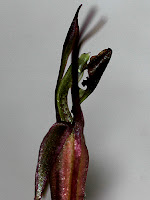but closed.
I have concluded that it is a Small Wasp Orchid (Chiloglottis sylvestris), although, disconcertingly, the standard texts seem to disagree with photos and names of Chiloglottis sylvestris and C. seminuda). So, my naming of the "Turtle Orchid" Chiloglottis seminuda on 17 April is up in the air for now. I shall correct it when I get confirmation of which authority is correct.
With the aid of a magnifying lens, one can see that the labellum has the typical "callus" of the Wasp and Ant Orchid group (see 3rd photo).
Flower from the rear
 The dorsal sepal is strongly pointed, and it closely wraps around the "column" of the flower. The most obvious feature is the little "arms" which are sticking up in the air. In fact these are held up this way because after pollingation, the flower closes the lip ("labellum") and the lateral sepals (the things which look like tiny arms) get lifted up in the air.
The dorsal sepal is strongly pointed, and it closely wraps around the "column" of the flower. The most obvious feature is the little "arms" which are sticking up in the air. In fact these are held up this way because after pollingation, the flower closes the lip ("labellum") and the lateral sepals (the things which look like tiny arms) get lifted up in the air.Confused?
I am a bit, too.
Side on view shows the
"callus" protruding
 The "callus", a warty gland on the labellum of the flower, is just visible beneath the green "column".
The "callus", a warty gland on the labellum of the flower, is just visible beneath the green "column".It is the shape of the callus which is probably the most distinctive feature of the flower.
Leaves on the ground
 The leaves are not a match to those described in the books. For some reason these plants have solitary leaves. That seems to be unusual.
The leaves are not a match to those described in the books. For some reason these plants have solitary leaves. That seems to be unusual.Paired leaves, which
have been eaten
 Some plants appear to have "paired" leaves, which is regarded as normal.
Some plants appear to have "paired" leaves, which is regarded as normal.The photos are terrible, because i found these plants in the late afternoon, in deep shade, in a Melaleuca thicket. So it was quite dark.
The soil is a muddy creek bed. I have to go back and be prepared to get wet (lie down in the mud, probably) in order to try and get better shots.
All of the flowers I saw today were already closed, but I hope that perhaps I will find some more plants with open flowers (if I am lucky).

No comments:
Post a Comment